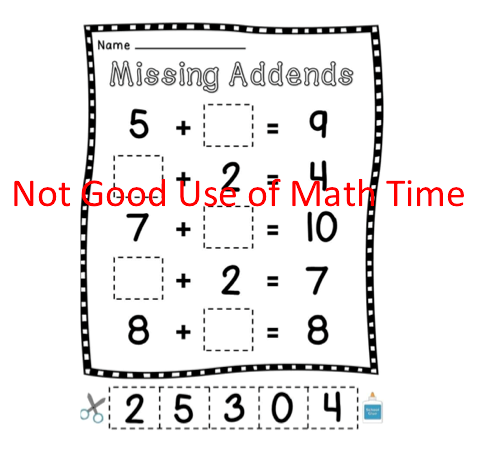 All the learning minutes of the school day matter — in fact, if you are like me, often what I had planned for a given school day was not accomplished. Things took more time than I had expected, or there were interruptions to the day. The learning time seemed to go by so quickly.
Because learning time is a precious commodity, it is critical that we, as educators, think carefully about what mathematical tasks we are giving our students to do. Is the task worth the time it takes to do it? Are we getting good value for the time spent? Are we getting “bang for our buck”?
This is true for teachers at every grade level. But I am going to be a little bold here and say this is especially true for primary teachers: those who are teaching students in Kindergarten, grade 1, grade 2, and grade 3. There are so many activities available at the touch of a computer key, but certainly not all of them give us good value for the time spent.
Two examples of such activities are pictured here. In one, the students are asked to colour the picture based on the sums of the problems on the page. Can you see the problem with this task? The students are likely to spend more time colouring than engaged in math thinking. There is nothing wrong with colouring — I know it helps develop fine motor skills in these little people. The problem is that much of the time set aside for math is usurped by the colouring part of the activity. In the second picture there is a similar conflict. There are five math questions to solve, but the cutting and pasting of the numbers for the answers will take much longer. Again, cutting is a great skill, one which students should develop. I just think it is sad to have students cutting and pasting during math time in which I can have them developing number sense through more meaningful tasks.
I want to encourage you to jealously guard the math learning time that you have with your students. Use your critical thinking skills to evaluate prospective tasks (no matter where they come from!) and choose those that are truly valuable, those that don’t waste math time. By all means, have your students cut, colour, and paste. Just do it in art time, not math time!
According to Howden, number sense “develops gradually as a result of exploring numbers, visualizing them in a variety of contexts, and relating them in ways that are not limited by traditional algorithms.” (Arithmetic Teacher, NCTM, February, 1989, p. 11.) Is your activity one that allows students to explore numbers, visualize them, and make connections to other math concepts? Is the task worth the time?
Mathematically yours,
Carollee
All the learning minutes of the school day matter — in fact, if you are like me, often what I had planned for a given school day was not accomplished. Things took more time than I had expected, or there were interruptions to the day. The learning time seemed to go by so quickly.
Because learning time is a precious commodity, it is critical that we, as educators, think carefully about what mathematical tasks we are giving our students to do. Is the task worth the time it takes to do it? Are we getting good value for the time spent? Are we getting “bang for our buck”?
This is true for teachers at every grade level. But I am going to be a little bold here and say this is especially true for primary teachers: those who are teaching students in Kindergarten, grade 1, grade 2, and grade 3. There are so many activities available at the touch of a computer key, but certainly not all of them give us good value for the time spent.
Two examples of such activities are pictured here. In one, the students are asked to colour the picture based on the sums of the problems on the page. Can you see the problem with this task? The students are likely to spend more time colouring than engaged in math thinking. There is nothing wrong with colouring — I know it helps develop fine motor skills in these little people. The problem is that much of the time set aside for math is usurped by the colouring part of the activity. In the second picture there is a similar conflict. There are five math questions to solve, but the cutting and pasting of the numbers for the answers will take much longer. Again, cutting is a great skill, one which students should develop. I just think it is sad to have students cutting and pasting during math time in which I can have them developing number sense through more meaningful tasks.
I want to encourage you to jealously guard the math learning time that you have with your students. Use your critical thinking skills to evaluate prospective tasks (no matter where they come from!) and choose those that are truly valuable, those that don’t waste math time. By all means, have your students cut, colour, and paste. Just do it in art time, not math time!
According to Howden, number sense “develops gradually as a result of exploring numbers, visualizing them in a variety of contexts, and relating them in ways that are not limited by traditional algorithms.” (Arithmetic Teacher, NCTM, February, 1989, p. 11.) Is your activity one that allows students to explore numbers, visualize them, and make connections to other math concepts? Is the task worth the time?
Mathematically yours,
Carollee

